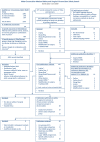Systematic review: Safety of surgical male circumcision in context of HIV prevention public health programmes
- PMID: 37089877
- PMCID: PMC10115943
- DOI: 10.12688/gatesopenres.13730.2
Systematic review: Safety of surgical male circumcision in context of HIV prevention public health programmes
Abstract
Background: Since the recommendation of voluntary medical male circumcision (VMMC) to reduce the risk of heterosexually acquired HIV, a number of adolescent boys and men in 15 priority countries in Africa have been circumcised. Our primary goal was to identify the incidence of adverse events (AEs) associated with VMMC and to assess the safety profile among adolescent boys 10 - 14 years. Methods: We searched the databases MEDLINE and Embase, WHO, and conference abstracts from 2005 to 2019. The incidence of AEs was estimated by type of AE, size of study and age. Results: We retained 40 studies. Severe and moderate AEs overall were estimated at 0.30 per 100 VMMC clients with wide variability per study type. A higher rate was noted in small and moderate scale programmes and device method research studies compared with larger scale programmes. There was a limited number of studies reporting AEs among younger adolescent boys and they had higher infection-related AEs than those aged 20 years and older. Case studies noted rare AEs such as necrotizing fasciitis, tetanus, and glans injury. Conclusions: AE rates were comparable to those from the randomized controlled trials (RCTs) that led to recommendations and implementation of VMMC in high HIV burden countries, despite being implemented in low resource settings. Clients over time have increasingly included adolescents under the age of 15 years. Studies suggest potentially higher risks in this age group. As VMMC services are sustained, patient safety surveillance systems and promoting a patient safety culture are crucial to identify and mitigate potential harms from medical male circumcision.
Keywords: Africa; adolescent; adverse event; human immunodeficiency virus infection; male urologic surgical procedures; voluntary medical male circumcision.
Copyright: © 2023 Jindai K et al.
Conflict of interest statement
No competing interests were disclosed.
Figures




References
-
- WHO/UNAIDS: New Data on Male Circumcision and HIV Prevention: Policy and Programme Implications.Geneva, Switzerland: World Health Organization and Joint United Nations Programme on HIV/AIDS; 2007. Reference Source
-
- UNAIDS: Global AIDS Update: Communities at the Centre.Geneva, Switzerland: Joint United Nations Programme on HIV/AIDS; Report No.: UNAIDS/JC2956, 2019. Reference Source
Publication types
Associated data
Grants and funding
LinkOut - more resources
Full Text Sources
Research Materials

